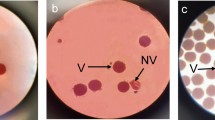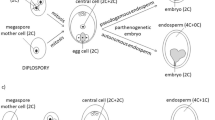Abstract
Chromosome numbers were counted inButomus umbellatus from 99 localities in both Czech and Slovak Republics and the karyotype morphology was studied. Basic chromosome sets are asymmetrical and uniform among diploids (2n=26) and triploids (2n=39). Diploids occur less frequently than triploids in this region. Their clonal populations are usually fertile owing to self-compatibility. The clonal populations of triploids are selfincompatible and usually sterile. Thus, the different self-compatibility is the main biological character distinguishing diploids from triploids. Pollen of triploids is viable in spite of meiotic irregularities in pollen mother cells (PMCs). Hybridization both between cytotypes and between the different triploid genets may take place, if they occur sympatrically. Offspring having diverse chromosome numbers between diploid and triploid level can originate as the consequence of such hybridization.
Similar content being viewed by others
Literature cited
Aspinwall N. &Christian T. (1992): Pollination biology, seed production, and population, and population structure in queen-of-the prairie,Filipendula rubra (Rosaceae) at Botkin Fen, Missouri.—Amer. J. Bot. 79: 448–494.
Bittrich V. &Kadereit J. (1988): Cytogenetical and geographical aspects of sterility inLysimachia nummularia.—Nord. J. Bot. 8: 325–328.
Briggs D. &Walters S. M. (1984): Plant variation and evolution. Second edition.—Cambridge University Press, Cambridge, London etc.
Bruneau A. &Anderson G.J. (1988): Reproductive biology of diploid and triploidApios americana (Leguminosae).—Amer. J. Bot. 75: 1876–1883.
Carr B.L. (1986): Autotriploidy inErythronium rostratum (Liliaceae): reproduction, distribution and origin.— Castanea 51: 73–87.
Ehrendorfer F. (1980): Polyploidy and distribution.—In:Lewis W. H. [ed.]: Polyploidy. Biological relevance.—Plenum Press, New York & London, pp. 45–60.
Ellstrand N.C. &Roose M.L. (1987): Patterns of genotypic diversity in clonal plant species.—Amer. J. Bot. 74: 123–131.
Eriksson O. &Jerling L. (1990): Hierarchical selection and risk spreading in clonal plants.—In:van Groenendael J. &de Kroon H. [eds.]: Clonal growth in plants: regulation and function.— SPB Academic Publishers, The Hague, pp. 79–94.
Fedorov A.A. (1969): Chromosomnyje čisla cvetkovych rastenij (Chromosome numbers in flowering plants).—Nauka, Leningrad.
Gadelia T.W.J. &Kliphuis E. (1963): Chromosome numbers of flowering plants in the Netherlands.—Acta Bot. Neerl., 12: 195–230.
Gottschalk W. (1976): Die Bedeutung der Polyploidie für die Evolution der Pflanzen.—Gustav Fischer Verlag, Stuttgart.
Grant V. (1981): Plant speciation. Second edition.—Columbia University Press, New York.
Harada I. (1956): Cytological studies inHelobiae. I. Chromosome idiograms and a list of chromosome numbers in seven families.—Cytologia 21: 306–328.
Hayman D.L. &Richter J. (1992): Mutations affecting self-incompatibility inPhalaris coerulescens Desf. (Poaceae).—Heredity 68: 495–503.
Hejný S. (1960): Ökologische Charakteristik der Wasser- und Sumpfpflanzen in der Slowakischen Tiefebenen (Donau- und Theissgebiet).—SAV, Bratislava.
Hroudová Z. (1980): Ekologická studie druhuSagittaria sagittifolia L.,Butomus umbellatus L.,Bolboschoenus maritimus (L.)Palla,Oenanthe aquatica (L.)Poir. (Ecological study of the speciesSagittaria sagittifolia L.,Butomus umbellatus L.,Bolboschoenus maritimus (L.)Palla,Oenanthe aquatica (L.)Poir).—Ms., Ph.D. Thesis, Praha.
Hroudová Z. &Zákravský P. (1993a): Ecology of two cytotypes ofButomus umbellatus II. Reproduction, growth and biomass production.—Folia Geobot. Phytotax. 28: 413–424.
Hroudová Z. &Zákravský P. (1993b): Ecology of two cytotypes ofButomus umbellatus III. Distribution and habitat differentiation in the Czech and Slovak Republics.—Folia Geobot. Phytotax. 28: 425–435.
Jackson R.C. &Casey J. (1980): Cytogenetics in polyploids.—In:Lewis W.H. [ed.]: Polyploidy. Biological relevance.—Plenum Press, New York & London, pp. 17–44.
Kadereit J.W. (1991): A note on the genomic consequences of regular bivalent formation and continued fertility in triploids.—Plant Syst. Evol. 175: 93–99.
Kartashova N.N. et al. (1974): Study of the chromosomes of the representatives of the Ob region flora. I. Number of chromosomes of the Tomsk district.—Nauč. Dokl. Vyš. Šk., Biol. Nauk. 4: 114–119.
Levan A., Fredga K. &Sandberg A.A. (1964): Nomenclature for centromeric position on chromosomes. —Hereditas 52: 201–220.
Lewis D. (1947): Competition and dominance of incompatibility alleles in diploid pollen.—Heredity 1: 85–108. n.v., cit. sec.Richards J. (1986), pp. 210.
Lewis D. (1949): Incompatibility in flowering plants.—Biol. Rev. 24: 427–469. n.v., cit. sec.Richards J. (1986), pp. 210.
Lin S.-J. et al. (1992): Diploid and triploid offspring of triploid agamospermous fernDryopteris pacifica.— Bot. Mag. Tokyo 105: 443–452.
Lincoln R.J. &Boxshall G.A. &Clark P.F. (1982): A dictionary of ecology, evolution and systematics.—Cambridge University Press, Cambridge, London etc.
Lohammar G. (1931): Two chromosome numbers inButomus umbellatus L.—Svensk Bot. Tidskr. 25: 495–499.
Lohammar G. (1954): Bulbils in the inflorescences ofButomus umbellatus.—Svensk Bot. Tidskr. 48: 485–488.
Löve Á. & Löve D. (1948): Chromosome numbers of northern plant species.—Dep. Agric. Rep., Series B, no. 3., Reykjavik.
Löve Á. &Löve D. (1974): Cytotaxonomical atlas of the Slovenian flora.—J. Cramer, Lehre.
Löve Á. &Löve D. (1980): Chromosome number reports LXIX.—Taxon 29: 707–709.
Měsíček J. &Jarolímová V. (1992): List of chromosome numbers of the Czech vascular plants.— Academia, Praha.
Moret J. (1991): Les strategies de reproduction du complexe polyploïdeOrnithogalum umbellatum (Hyacinthaceae) en France.—Bull. Mus. natl. Hist. nat., 4e ser., 13, sect. B, Adansonia 1–2: 25–46.
Murín A. (1976): Index of chromosome numbers of Slovakian flora. Part 5.—Acta Fac. Rerum Nat. Univ. Comenianae, Bot. 25: 1–18.
Murín A. (1987): Kvety ako indikátory mutagenity a fytotoxicity znečisteného životného prostredia (Flowers as indicators of mutagenic and phytotoxic impact of polluted environment).—Biológia, Bratislava, 42: 447–456.
Pandita T. K. &Mehra P. N. (1984): Cytological studies of someHelobiales of Kashmir Himalayas. II. FamiliesButomaceae andHydrocharitaceae.—Cytologia 49: 305–312.
Pohl F. (1935): Ein Fall von zweckloser Proterandrie (Butomus umbellatus L.).—Ber. Deutsch. Bot. Ges. 53: 779–782.
Probatova N.S. &Sokolovskaya A.P. (1984): Čisla chromosom predstavitelej semejstvButomaceae, Papaveraceae, Poaceae s Dalnevo Vostoka SSSR (Chromosome numbers of the representatives of the familiesButomaceae, Papaveraceae, Poaceae from Far East of the USSR).—Bot. Žurn. 69: 409–411.
van Raamsdonk L.W.D. (1985): Pollen fertility and seed formation in theOrnithogalum umbellatum/angustifolium complex (Liliaceae/Scilloideae).—Pl. Syst. Evol. 149: 287–297.
Rao Y.S. (1953): Karyo-systematic studies inHelobiales. I.Butomaceae.—Proc. Natl. Inst. Sci., India, 19: 563–581.
Richards A. J. (1986): Plant breeding systems.—Allen & Unwin, London.
Seawey S.R. &Bawa K.S. (1986): Late-acting self-incompatibility in Angiosperms.—Bot. Review 52: 195–219.
Sharma A.K. &Chatterjee T. (1967): Cytotaxonomy ofHelobiae with special reference to the mode of evolution.—Cytologia 32: 286–307.
Skalińska M. et al. (1961): Further additions to chromosome numbers of Polish Angiosperms.—Acta Soc. Bot. Polon. 30: 463–489.
Stebbins G.L. (1971): Chromosomal evolution in higher plants.—E. Arnold Ltd., London.
Stebbins G.L. (1980): Polyploidy in plants: unsolved problems and prospects.—In:Lewis W.H. [ed.]: Polyploidy. Biological relevance, Plenum Press, New York & London, pp. 495–520.
Thompson J.D. &Lumaret R. (1992): The evolutionary dynamics of polyploid plants: origins, establishment and persistence.—Trends in Ecol. and Evol. 7: 302–307.
Uchiyama H. (1989): Karyomorphological studies on some taxa of theHelobiae.—J. Sci. Hiroshima Univ., Ser.B, Div. 2, 22: 271-352.
Uotila P. &Pellinen K. (1985): Chromosome numbers in vascular plants from Finland.—Acta Bot. Fenn. 130: 1–37.
Urbańska K.M. (1985): Some life history strategies and population structure in asexually reproducing plants.— Bot. Helv. 95: 81–97.
Volfová D. (1985): Příiny malé produkce semen u šmele okoličnatého (Butomus umbellatus L.)—rostliny uvažované pro spevňování břehů vodních toků (The causes of low seed production inButomus umbellatus L.—the plant considered as suitable for fixation of stream shores).—Ms., Dipl. Thesis, Brno.
de Wet J.M.J. (1980): Origins of polyploids.—In:Lewis W.H. [ed.]: Polyploidy. Biological relevance.—Plenum Press, New York & London, pp. 3–15.
Woodhead T.W. &Kirchner O. (1908):Butomaceae.—Kirchner O., Loew E. &Schröter C. [Eds.]: Lebensgeschichte der Blütenpflanzen Mitteleuropas, Vol. 1/1.—E. Ulmer, Stuttgart, pp. 648–664.
Author information
Authors and Affiliations
Rights and permissions
About this article
Cite this article
Krahulcová, A., Jarolímová, V. Ecology of two cytotypes ofButomus umbellatus I. Karyology and breeding behaviour. Folia geobot. phytotax. 28, 385–411 (1993). https://doi.org/10.1007/BF02853305
Received:
Accepted:
Issue Date:
DOI: https://doi.org/10.1007/BF02853305




